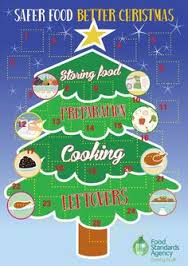Food Safety Tips at Christmas Time
Purchasing/Shopping
Only buy from reliable Suppliers – Buy Irish & buy from your local Craft Butcher. The Butcher will supply you with traditionally cured meats & will be able to vouch for where the meat came from. Traceability is a legal requirement & the customer is entitled to know the source of any meats they buy. Members of the Association of Irish Craft Butchers welcome such queries from customers. Collect meats close to Christmas & place in fridge straight away & do not leave at room temperature
Storage
Set Fridge between 1 to 5 degrees Celsius. Avoid overload & rotate stock on a first in-first out basis. Organize your fridge to ensure that all raw meats are on the bottom shelves. If you are tight on space, place drinks in a covered box/case outside the back door.
If you are defrosting a frozen turkey – place in the fridge & allow 24hours for every 4/5 lbs weight.
Golden Rule: do not leave perishable food at ambient temperature.
Preparation
Washing the cavity of your turkey will not kill bacteria-only cooking properly will kill bacteria. Experts argue that bacteria can spread by water splashes; however, if you use an anti-bacterial spray around the sink afterwards there will be no problem. I always wash the cavity of our turkey with a little salted water & dry with kitchen paper. It is safe to stuff the turkey but do not pack tightly-allow room for heat & juices to circulate.
Cooking
Start at a high heat for the first 30 minutes, then lower to 170c for 3.5 hrs approx, then remove foil, raise temperature & cook uncovered for the last 30 minutes. Allow to rest for 30 minutes before serving. Remember stuffing slows down cooking time, so allow extra time for stuffing – take into consideration the extra weight
of stuffing. To test – pierce the thickest part of the leg – the juices should be clear & golden-no trace of pink. Or buy a simple probe thermometer €12. Cook to 75 degrees+
Leftovers
Do not leave leftovers on the counter for the remainder of the day. Remove meat from the carcass & refrigerate within 2 hours of service. Once refrigerated it should be eaten within 3 days. Before using the leftovers, remove from fridge to “acclimatize” for an hour. Diced leftover meats can make a delicious St Stephens Day Pie.
Reheated food should be steaming hot the whole way through.
Transporting of Food
Wrap hot food in tin foil & cover with a towel. If food is cold, place in a freezer bag/cool box with ice.
Wash-Up & Cleaning
Many have dishwashers but if you are washing up ware & cutlery by hand – ensure the water is hot & clean. Use anti-bacterial wash-up liquid & rinse clean. Ideally allow ware, etc to air dry. Tea cloths can cause indirect cross contamination. Use once & launder afterwards.
Use different cloths for different jobs or use Kitchen paper for wiping down. Wash & sanitise worktops thoroughly after raw meat.
One does not have to spend a fortune on cleaning chemicals – Hot water & old fashioned methods like using lemon juice or bread soda are just as good. Remember water at 82° Celsius is the best disinfectant of all.
Hand washing: It takes 20 seconds – use hot water, anti-bacterial soap & dry thoroughly with paper towel.
Summary-the 4 Cs
1. COOK meat to 75 degrees, ensure it is steaming hot & juices run clear.
2. CLEAN hands before handling food, clean utensils, scrub chopping boards & have separate chopping boards for raw & cooked food.
3. COVER & separate Raw from cooked foods.
4. CHILL food to prevent spoilage & deterioration.
Tags: Christmas, Christmas Dinner, food poisoning, storage, Turkey


